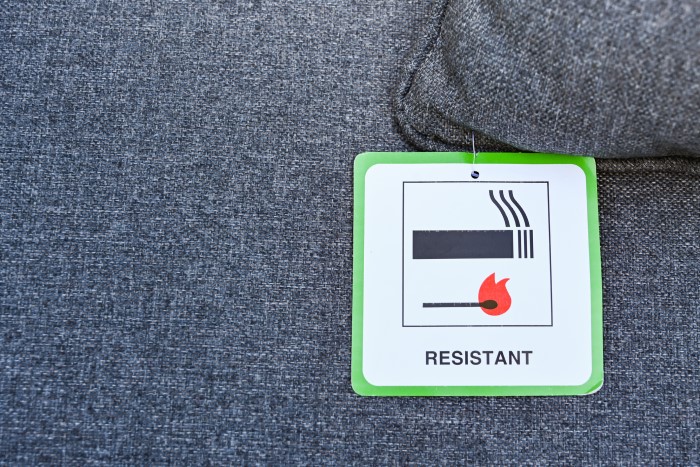Concerns About Chemical Fire Retardants: What Interior Designers Need To Know
There is growing disquiet about chemical fire retardants used in the UK as one of the ways to ensure furniture and furnishings meet fire safety regulations. We look at the issues.

Fire safety regulations for furniture and furnishings in the UK create strict requirements for manufacturers and providers. The use of chemical fire retardants is one of the methods by which they can be met, but profound concerns about their persistence in the environment and effects on human health have led to calls for change. The issues are directly relevant to interior designers and, here, we outline the UK regulations and the differences internationally; the concerns that exist about the chemicals used; and the changes to the regulations that have been requested.
UK regulations
The Furniture and Furnishings (Fire) (Safety) Regulations 1988 cover both the testing and labelling of domestic furniture. They apply to a range of items including upholstered seating and nursery furniture and headboards; the filling materials of divans, mattresses and pillows; the fillings of scatter cushions and seat pads; permanent, loose and stretch covers for furniture; and foam and non-foam filling material for furniture. Testing is done using ignition sources specified in the relevant British Standards, including a smouldering cigarette test, a match test that uses a small gas flame, and a large gas flame.
Fire retardancy can be achieved in different ways, including the use of chemical fire retardants which might be applied via a process of chemical dipping or coating. The chemicals used include aluminium hydroxide, the most used flame retardant worldwide, and which is generally regarded as safe. However, a group of flame retardants, referred to as ‘organic’, are more disputed. These are carbon-based and include brominated (BFRs), chlorinated and organophosphorus flame retardants, which are all believed to pose a risk to human health and the environment.
UK fire safety requirements are some of the strictest, and have significant differences from those in the rest of Europe and the USA. However, the 2019 report of the parliamentary Environmental Audit Committee entitled ‘Toxic chemicals in everyday life’ found that while the rate of UK fire deaths declined when the fire safety regulations were introduced and continued to decline, a ‘comparison of deaths from fire in the UK and New Zealand since the 1970s shows a similar rate of decline, despite New Zealand having no furniture flammability regulations’. The committee stated: ‘There is disagreement about the contribution of flame retardants to this reduction.’
Chemical concerns
There are a number of concerns regarding the chemicals used for fire retardancy in terms of both their health and environmental effects. The Environmental Audit Committee’s report stated: ‘Flame retardants have been detected in air, soil, water, food, wildlife and humans. They are present in homes and offices via dust and on surfaces including windows, floors and carpets. Exposure occurs when additive flame retardants leach from goods into the air, dust and surfaces.’
The committee also reported that: ‘There is a growing body of research that some flame retardants pose a threat to human health and the environment. The Cancer Prevention and Education Society noted the effects include “cancer, neurotoxicity, developmental, behavioural, endocrine, metabolic, reproductive, developmental and allergy.”’
Calls for changes to the regulations
The Environmental Audit Committee’s ‘Toxic chemicals in everyday life’ report contained clear requests for change to reduce public exposure to chemicals. It stated: ‘As proposed in the 2016 consultation, we call on the government to remove children’s products from [the] scope of the 1988 regulations without further delay. The government should also introduce a new permanent label for all upholstered furniture products containing flame retardants. This should clearly state if the product has been treated with chemical flame retardants and list all chemicals used, including those below the substance of very high concern threshold. The label should also direct consumers to an online platform where they can view independent scientific advice on the relative toxicity of the chemicals listed.’
Breast Cancer UK has also called for ‘changes to the UK’s furniture fire safety regulations that remove the need for the use of organic flame retardants and create genuine impetus for designing out both flammability and toxicity’ in its background briefing on flame retardants. Its other recommendations include: ‘The eventual phase out of hazardous flame retardants in all consumer and industrial products and their replacement with safer alternatives.’
The future
The Furniture and Furnishings (Fire Safety) Regulations 1988 have been under review for more than 10 years. However, delays and missed deadlines have meant the timeline is not certain, and the government Office for Product Safety & Standards has not yet confirmed a date for delivery of new regulations.
Hazardous flame retardants are one of the priorities as part of the 2022 to 2023 UK REACH work programme. UK REACH is part of the regulatory regime for chemicals in Great Britain (England, Scotland and Wales), and its statutory purpose is to ensure a high level of protection for human health and the environment in Great Britain. The agreed action is ‘The Environment Agency will review and update its risk assessment on flame retardants, published in 2003, to feed into wider chemicals policy.’
Explore new resources from the BIID. Seeing a padlock? Just login or become a member to view.
View the highlights from our 60th anniversary party
We asked Anna Burles: What makes the perfect software?
Discover the smart home technology awards with Platinum Partner, CEDIA
Explore the latest, member-exclusive, templates designed to make your life easier.
University of Gloucestershire wins the BIID Student Design Challenge 2025.





